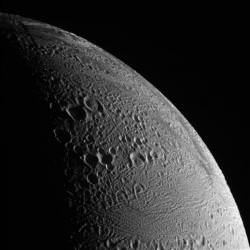The Cassini spacecraft’s audacious flyby of Saturn’s moon Enceladus on March 12 has provided scientists more information about the geyser-like jets of ice shooting from the moon’s southern hemisphere. It also highlighted the drastic geologic differences between the moon’s north and south pole. While the data collected from the geysers is still being analyzed, images from the flyby showed a north polar region that is older and pitted with fractured craters, compared to the relatively newer cracks in south pole area from which water jets are emanating. The spacecraft came within 50 kilometers (30 miles) of the surface at closest approach and 200 kilometers (120 miles) while flying through the plume.
“These new images are showing us in great detail how the moon’s north pole differs from the south, an important comparison for working out the moon’s obviously complex geological history,” said Carolyn Porco, Cassini imaging team leader. “And the success of yesterday’s daring and very low-altitude flyby means this coming summer’s very close encounter, when we get exquisitely detailed images of the surface sources of Enceladus’ south polar jets, should be an exciting ‘next big step’ in understanding just how the jets are powered.”
Cassini was traveling about 15 kilometers per second (32,000 mph) through plumes from the geysers. The flyby was designed so that Cassini’s particle analyzers could dissect the “body” of the plume for information on the density, size, composition and speed of the particles.
Cassini scientists are pouring over the data being returned, which will give them a better understanding of the unique plume environment of Enceladus and possibly how the geysers are being formed.
The images show the north polar region is much older and pitted with craters of various sizes. These craters are captured at different stages of disruption and alteration by tectonic activity, and probably from past heating from below. Many of the craters seem sliced by small parallel cracks that appear to be ubiquitous throughout the old cratered terrains on Enceladus.
Future close flybys may bring Cassini even closer to the surface of Enceladus. The spacecraft will come close to Enceladus again in August, and skim even closer to the moon’s surface in October.
Original News Source: JPL Press Release


Holy, how close are they going to push it???
“October’s flyby is anticipated to scrape a runnel of at least 18 feet deep in the surface of Enceladus. It is not anticipated that this should cause any disruption to Cassini’s orbit as the added speed coming from geysers created by this burrowing should carry it on its way.”
“The Enceladians are looking for a way to deflect this alien probe before it returns and chases the innocent women and children as it skims the parks and playgrounds!”
That is serious math to make sure it doesn’t just make a big crater. We rock!
My prediction: It will be found to be the result of a recent large meteoric collision on the southern end of Enceladus. The crater is masked by the resulting geysers.
“Cassini scientists are pouring over the data ” Water, coffee, what liquid? The word you are looking for is “poring”.
Can’t wait to see their finding for what wexactly the plumes are made of.